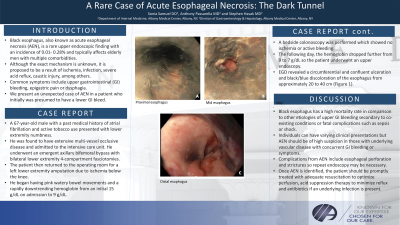Monday Poster Session
Category: Esophagus
P1936 - A Rare Case of Acute Esophageal Necrosis: The Dark Tunnel
Monday, October 23, 2023
10:30 AM - 4:15 PM PT
Location: Exhibit Hall

Has Audio

Sonia Samuel, DO
Albany Medical Center
Albany, NY
Presenting Author(s)
Sonia Samuel, DO1, Anthony Passarella, MD2, Stephen Hasak, MD, MPH2
1Albany Medical Center, Albany, NY; 2Albany Medical College, Albany, NY
Introduction: Black esophagus, also known as acute esophageal necrosis (AEN), is a rare upper endoscopic finding with an incidence of 0.01- 0.28% and typically affects elderly men with multiple comorbidities. Although the exact mechanism is unknown, it is proposed to be a result of ischemia, infection, severe acid reflux, caustic injury, among others. Common symptoms include upper gastrointestinal (GI) bleeding, epigastric pain or dysphagia. We present an unexpected case of AEN in a patient who initially was presumed to have a lower GI bleed.
Case Description/Methods: A 67-year-old male with a past medical history of atrial fibrillation and active tobacco use presented with lower extremity numbness. He was found to have extensive multi-vessel occlusive disease and admitted to the intensive care unit. He underwent an emergent axillary bifemoral bypass with bilateral lower extremity 4-compartment fasciotomies. The patient then returned to the operating room for a left lower extremity amputation due to ischemia below the knee. He began having pink watery bowel movements and a rapidly downtrending hemoglobin from an initial 15 g/dL on admission to 9 g/dL. A bedside colonoscopy was performed which showed no ischemia or active bleeding. The following day, the hemoglobin dropped further from 9 to 7 g/dL so the patient underwent an upper endoscopy. The esophagogastroduodenoscopy (EGD) revealed a circumferential and confluent ulceration and black/blue discoloration of the esophagus from approximately 20 to 40 cm (Figure 1).
Discussion: Black esophagus has a high mortality rate in comparison to other etiologies of upper GI bleeding secondary to co-existing conditions or fatal complications such as sepsis or shock. Individuals can have varying clinical presentations but AEN should be of high suspicion in those with underlying vascular disease with concurrent GI bleeding or symptoms. Complications from AEN include esophageal perforation and strictures so repeat endoscopy may be necessary. Once AEN is identified, the patient should be promptly treated with adequate resuscitation to optimize perfusion, acid suppression therapy to minimize reflux and antibiotics if an underlying infection is present.

Disclosures:
Sonia Samuel, DO1, Anthony Passarella, MD2, Stephen Hasak, MD, MPH2. P1936 - A Rare Case of Acute Esophageal Necrosis: The Dark Tunnel, ACG 2023 Annual Scientific Meeting Abstracts. Vancouver, BC, Canada: American College of Gastroenterology.
1Albany Medical Center, Albany, NY; 2Albany Medical College, Albany, NY
Introduction: Black esophagus, also known as acute esophageal necrosis (AEN), is a rare upper endoscopic finding with an incidence of 0.01- 0.28% and typically affects elderly men with multiple comorbidities. Although the exact mechanism is unknown, it is proposed to be a result of ischemia, infection, severe acid reflux, caustic injury, among others. Common symptoms include upper gastrointestinal (GI) bleeding, epigastric pain or dysphagia. We present an unexpected case of AEN in a patient who initially was presumed to have a lower GI bleed.
Case Description/Methods: A 67-year-old male with a past medical history of atrial fibrillation and active tobacco use presented with lower extremity numbness. He was found to have extensive multi-vessel occlusive disease and admitted to the intensive care unit. He underwent an emergent axillary bifemoral bypass with bilateral lower extremity 4-compartment fasciotomies. The patient then returned to the operating room for a left lower extremity amputation due to ischemia below the knee. He began having pink watery bowel movements and a rapidly downtrending hemoglobin from an initial 15 g/dL on admission to 9 g/dL. A bedside colonoscopy was performed which showed no ischemia or active bleeding. The following day, the hemoglobin dropped further from 9 to 7 g/dL so the patient underwent an upper endoscopy. The esophagogastroduodenoscopy (EGD) revealed a circumferential and confluent ulceration and black/blue discoloration of the esophagus from approximately 20 to 40 cm (Figure 1).
Discussion: Black esophagus has a high mortality rate in comparison to other etiologies of upper GI bleeding secondary to co-existing conditions or fatal complications such as sepsis or shock. Individuals can have varying clinical presentations but AEN should be of high suspicion in those with underlying vascular disease with concurrent GI bleeding or symptoms. Complications from AEN include esophageal perforation and strictures so repeat endoscopy may be necessary. Once AEN is identified, the patient should be promptly treated with adequate resuscitation to optimize perfusion, acid suppression therapy to minimize reflux and antibiotics if an underlying infection is present.

Figure: Figure 1. Acute Esophageal Necrosis. 1A- Upper to middle esophagus 1B- Middle esophagus 1C- Lower esophagus
Disclosures:
Sonia Samuel indicated no relevant financial relationships.
Anthony Passarella indicated no relevant financial relationships.
Stephen Hasak indicated no relevant financial relationships.
Sonia Samuel, DO1, Anthony Passarella, MD2, Stephen Hasak, MD, MPH2. P1936 - A Rare Case of Acute Esophageal Necrosis: The Dark Tunnel, ACG 2023 Annual Scientific Meeting Abstracts. Vancouver, BC, Canada: American College of Gastroenterology.
